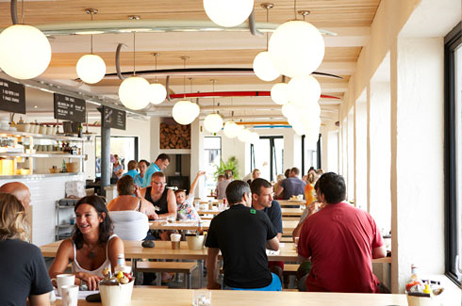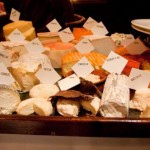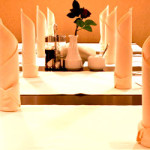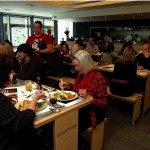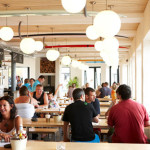Why do we eat out? It might not be practicable to go home and cook all the time, but there’s no doubt that dining out is far more than just convenience. If it were we would probably just grab fast food takeaways and be seen munching on McDonalds from the wrapper. Even though there are occasions when, like my time in Warwick these past 12 weeks, it’s been a practical necessity to eat out alone, usually it’s a social thing, a time and place where we can engage in conversation with friends, family, lover(s), business colleagues, whoever it might be.
But the place you choose to dine says a lot about how the meeting will progress, since the nature of the food, the ambience, the entertainment, the décor, the cost, the dress code – everything stamps its impression on our experience. You don’t have to spend a fortune to have a great time, but there are thousands of restaurants out there vying for your attention – so how do you decide?
Here my choice may differ from yours, but it seems to me there are three primary reasons why particular venues are chosen:
- Comfort factor – you know what you’re getting and everything is familiar (eg. A convenient place you’ve been to countless times before, a style of food you eat regularly, a branch of a chain serving identikit food in every place.)
- Trying out somewhere new, following a particular promotion, trying because a restaurant is well-reviewed, attempting an ethnic variant not yet within your repertoire etc. etc.
- Something special for a special occasion – a place to push the boat out.
In my case there are lots of places I’ve enjoyed, and if the occasion demands I would be happy to return to, but then there are so many more places to try so I go for something different as often as possible, and when I do I’ll look for something interesting, original and different on the menu. This is probably abnormal behaviour since there is a tendency for diners to gravitate towards their favourite steak/chicken/salmon, korma, sweet-sour or whatever it happens to be, a crumb of comfort as it were. But then as a self-confessed foodie I am definitely not typical. Food is a source of pleasure, not merely a refuelling stop.
So let’s just create a scenario here: you are with your other half in a strange town. Your train home is in 2 hours do you’ve got time for dinner first. Your iPhone tells you of many dining options in the centre of town, so you go look at a few. You could be in a street full of restaurants, all with menus on display and bright lights to tempt you inside. If you take Chinatown or Curry Mile, they might all be variants of the same ethnic style too… in which case, what criteria are you going to use to select one over countless others for your dinner out?
Granted that it could be a place recommended by friends or online, though that won’t always be the case – you may need to use your own eyes, ears and nose to pick the wheat from the chaff. The basics are probably that it’s in a reasonable area and looks relatively clean and salubrious, but then what? In some resorts there is someone on the door charged with pulling in the punters. Doubtless it works for some tho high-pressure selling will definitely make some clientele (like this one) run a mile.
Maybe that there are a few people there to create some buzz: an empty restaurant doesn’t encourage footfall, but then a place with people queuing out of the door might not help either. Is it pre-book only? Some make a pretence of being booked out when in fact they’re virtually empty, but then that’s just one game among many in the restaurant biz. Granted a table at the Ivy on spec might be a tad difficult… unless you’re a celeb of course.
What about the decor? Should it look smart, modern, traditional or idiosyncratic? Thinking back to the likes of Les Trois Garçons, that is an establishment both quirky and packed with character – I remember it fondly, where others might think of it as bring like a junk shop. Being different to the crowd may not have stood it in great stead as far as the press is concerned, but it’s always been good and stays long in the memory – no bad thing.
But I digress. Do you want music playing? If so, do you want to be able to hear yourself think? How bright or dim would the lighting have to be to put you off? How close are the tables packed together – will you be banging elbows with your neighbours? Certainly better to enjoy a bit of peace and quiet, unless you’ve chosen a place offering cabaret in the form of live music, for example. There are times when the communal canteen-style dining of Wagamama seems convivial and entertaining, but if the purpose of the meal is to enjoy a close and intimate conversation, Wagamama is the last place you would want to go.
Then there’s the menu. It might be displayed outside, and some potential customers might spend a long while deliberating over the choices on offer. Consequently, there needs to be instant appeal, not necessarily restricted to the dishes on offer – though the prices may of course impact your decision one way or another. Too cheap and you may simply think they can’t be of the standard expected; too dear and it may be beyond your price bracket or may indicate pretensions the restaurant can or cannot fulfil. Too grand for the occasion will not suit, and most meals out are more mundane than the very special celebrations where we do want to push out that proverbial boat.
Nevertheless, the food and drink must be enticing – even if for many it is not the primary attraction. For me it probably will be, even if many other factors influence the final judgement. The charm and attentiveness of service obviously helps, though you may not be aware of that at the time you enter the restaurant. You will however be aware if it is a self-service establishment, which is not altogether a bad thing but would not be appropriate for every setting (help yourself buffet at Le Gavroche? I think not.)
That said there might well be a centrepiece that captures your attention – a great cheese board or dessert trolley used to be fine examples, though they are both rarities these days. Buffets do have their wares on display, which might go some way to explaining their popularity, though a gimmick helps. One such beloved by everyone that tries them is the Teppanyaki style of Japanese cuisine, whereby everything is cooked by a chef on a hot plate in front of you, and not just cooked – it’s a form of cabaret, with eggs and utensils being juggled in the process. At one time waiters in French restaurants would don the apron and cook your stroganoff on a primus stove at the table, though that seems to have gone by the board too.
In the final analysis, you have to be comfortable with your choice, and be made to feel welcome. You need to be able to relax and enjoy your food without stress – which can on occasions be difficult when the establishment is trying to hurry you along to vacate the table for the next group of diners. A mismatch that leaves you uncomfortable will probably seal the restaurant’s fate, decide whether or not you would recommend it, and in my case determine how positive my review will be.
Ultimately there has to be a connection between the place, the food and the mood. If that connection is not established, you will not be tempted in and the restaurant won’t get your business, so it is in their interests to find ways to lure you in. The point of this rambling monologue is that I have no idea what it is that will lure me in, and being a fickle creature the mood I am in will change day to day, if not minute to minute. But if on my travels I spot somewhere that might fit another mood, I will take due note and return to it on another occasion. You never know when that information might come in handy!

